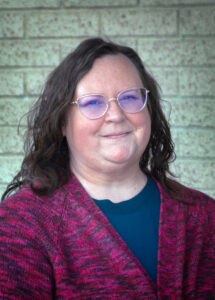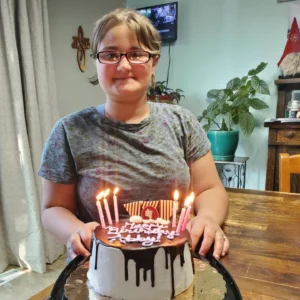Heather Schmidt's MPA Journey Teaches Resilience
Heather Schmidt, 44, a wife, mother to five, and an entrepreneur in the heart of central Minnesota, experienced jam-packed days that relied on seemingly boundless energy and a tight schedule for the first two decades of her marriage. Heather and Nathan were married 24 years ago and when they decided to start a family, they learned Heather had polycystic ovary syndrome.
 Heather had always wanted children and derives joy from family, so, the couple decided to adopt.
Heather had always wanted children and derives joy from family, so, the couple decided to adopt.
Their family grew, beginning with Lillian, now 16, followed by Kaitlin (25), Hannah (17), Abigail (13), and Finley (8).
During 2020, when COVID kept everyone isolated, Heather experienced unexplained itching. No one could diagnose it, so Heather just lived with it. Then in spring of 2023, she came down with a cold.
“I thought nothing of it and went on with our life,” Heather said.
But she didn’t get better and that led to an urgent care visit. Antibiotics temporarily relieved some of her symptoms, but Heather continued to experience a constant runny nose and a bit of a cough. Though the cold symptoms lingered, Heather pushed forward, assuming it was nothing serious.
That changed during a trip to Maryland to visit a friend in June 2023.
“We went to the ocean, and I struggled significantly trying to breathe while walking in the sand,” she said. “I chalked it up to being overweight. I also had extreme pain in my neck and shoulder and figured it was because I wasn’t sleeping in my own bed, and the drive there took 18 hours.”
However, by the end of each day, Heather was “absolutely dead tired” and running a low-grade fever (99° – 101° F). Even after returning home, she couldn’t shake the fatigue, low-grade fevers, and difficulty breathing.
In July 2023, Heather was admitted to St. Cloud Hospital in Minnesota, with pneumonia. She improved enough to be sent home six days later with antibiotics. But Heather’s condition didn’t get any better. She saw her primary care provider who put her on other antibiotics and a two-week course of prednisone. By August 2023, Heather developed back pain and was panting for air. Her symptoms became unbearable, forcing her to go to the emergency room.
Heather’s heart was racing, and her oxygen levels, which should have been between 95 and 100, were critically low at 76.
“Initially, the ER doctors just brushed it off as pneumonia,” Heather said. “I was then admitted to the hospital again, and Dr. Ramakanth Pata was assigned to my case.”
The next day doctors ran tests and performed a bronchoscopy. Everything came back negative but given her history of blood clots and prior lung scans showing a ‘ground glass appearance’ going back to 2017, Dr. Pata diagnosed interstitial lung disease, and considered the possibility of vasculitis. When Heather had been in the hospital for seven days, she was set up with mobile oxygen.
“It was embarrassing to be on 02 at the age of 43,” she said. “I always felt like I was being stared at. Sometimes someone would be nice enough to just ask me and I was willing to say what was up.”
 Heather’s primary care physician sent her to the Mayo Clinic in Rochester where she hit hurdles navigating the medical system. Heather had a referral for rheumatology and the doctors there said she should see their vasculitis pulmonologist, Dr. Misbah Baqir.
Heather’s primary care physician sent her to the Mayo Clinic in Rochester where she hit hurdles navigating the medical system. Heather had a referral for rheumatology and the doctors there said she should see their vasculitis pulmonologist, Dr. Misbah Baqir.
“It took a long time, over a year, for the insurance company to cover the initial appointment. There were lots of phone calls and refusals to pay.”
Dr. Baqir put Heather through a battery of tests. When the results came in, she finally had a name for her condition: microscopic polyangiitis (MPA) — a form of vasculitis that most commonly affects the small- to medium-sized blood vessels, particularly involving the kidneys, lungs, nerves, skin, and joints. MPA can worsen rapidly, so early diagnosis and treatment are essential to prevent kidney or respiratory damage, or organ failure. Heather’s treatment includes Tavneos, Rituxan and prednisone. Two infusions made her very ill. There may be more if her body can tolerate them.
The diagnosis, while a relief, brought its own set of challenges. While Heather is no longer reliant on oxygen, MPA has changed her life.
“MPA has been a struggle to just get laundry done,” she said. “Our laundry room is downstairs as we have a split-level home.” Heather, sapped of her energy and stamina, struggles to cook meals and do dishes. “I absolutely love to cook for my family. It’s my love language.”
The physical toll was significant, but MPA’s emotional impact was equally profound.
 “I have an immense amount of anxiety about getting sick, my kids getting sick and giving it to me, dying too soon and leaving my husband to care for our kids who can be challenging on a good day,” Heather said.
“I have an immense amount of anxiety about getting sick, my kids getting sick and giving it to me, dying too soon and leaving my husband to care for our kids who can be challenging on a good day,” Heather said.
Heather candidly shared the grief of losing the life she once knew. The decline in her health meant putting her photography career on hold. Her husband has taken on many of the household chore and other family responsibilities.
“My photography business is no longer,” Heather said. “I have let down several clients and I can’t live with that. Those are their precious memories, and they trusted me. I felt it best to stop the business and only do it as a hobby and only photographing my own children.”
The loss of her “former self” can sometimes take her out of the moment, but with the help of a compassionate therapist, she is learning to navigate her grief. Her family is also in therapy and their therapists are helping her children cope with their emotions.
“They are afraid of another long hospital stay. A mom being that sick for any kiddo is extremely scary. I haven’t been able to be active and be the hands-on mom that I was,” Heather said. “It has forced them to think of others instead of themselves. I guess  it is teaching them empathy.”
it is teaching them empathy.”
Despite the hardships, Heather remains hopeful.
“I look forward to getting back to the gym and building up my stamina again,” she said. “I also look forward to getting my camera out and shooting.”
In the meantime, Heather tries to support others who are scared and struggling with their own diagnosis journeys.
“I am more active in the AAV (ANCA-associated vasculitis) group than I am in the main vasculitis group,” she said. “My heart goes out to anyone having to deal with the questions of diagnosis and waiting.
The beginning is hard and scary. When doctors find the right medication regimen, remission is possible. It’s a process, but it does get better.”
Throughout her own journey, Heather leans on two mantras: “God doesn’t give us more than we can handle,” and “One day at a time.” These words, along with the love and support of her family, provide her with the strength she needs to face each day with determination and hope for the future.
